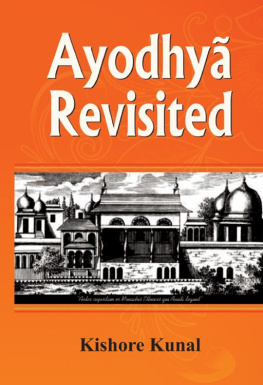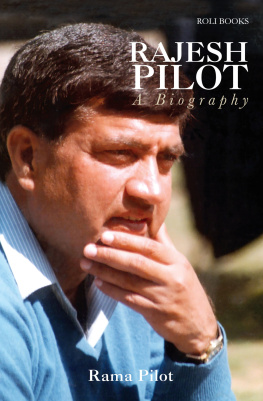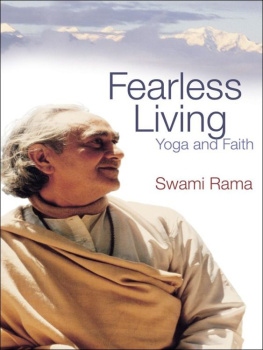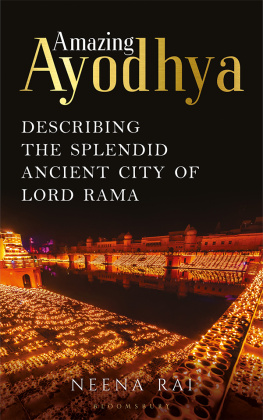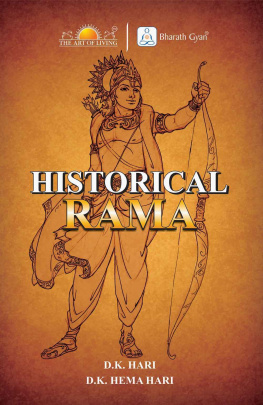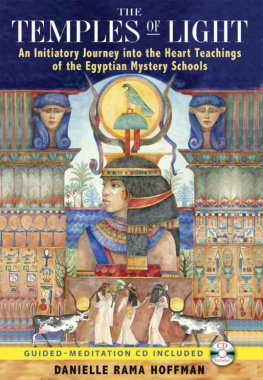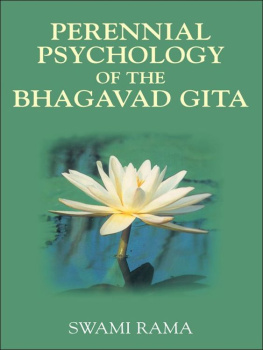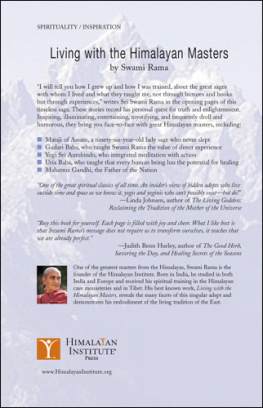Ayodhya Revisited
Kishore Kunal

This book is dedicated
to
Austrian Jesuit Priest
Father Joseph Tieffenthaler
who was the first person
to mention and write comprehensively
on the disputed shrine of Ayodhya
in his magnum opus Descriptio Indiae
written in Latin in c. 1770 A.D.
and
English merchant William Finch (1610 A.D.)
Dutch geographer Joannes De Laet (1631 A.D.)
British traveller Thomas Herbert (1634 A.D.)
French scholar C. Mentelle (1801 A.D.)
whose compact writings are
eloquent testimony to
many momentous events
of the holy city.
JUSTICE G.B. PATNAIK
Former Chief Justice of India
Foreword
S hri Kishore Kunal, a former IPS Officer and Vice Chancellor of a Sanskrit University, gave me a manuscript of Ayodhya Revisited consisting of around pages with a request to write Foreword. Even though I am not a historian, yet the subject is so very interesting and the approach of the writer is so very innovative that I have taken considerable time in going through the manuscript.
Ayodhya has been a centre of controversy for a considerable period and the controversy aggravated after the demolition of Babri Mosque. Ayodhya is known not only as a place of pilgrimage, but also as a seat of Indias culture. Historians, intellectuals and travellers have visited this place and given scholarly accounts of contemporary history, but Kunal has approached the subject from a different perspective. He has tried to draw his conclusion on objective and independent interpretation of materials and documents. He has tried to throw light on many aspects essentially on the basis of Sanskrit text.
In the very preface of the manuscript he has indicated the method of interpretation he has followed. The method adopted by him for Sanskrit sources prescribes replacing of words appearing in the text in their natural sequence to drive the correct meaning. The method is called anvaya method. Kunal has obtained materials and evidences from reputed sources like National Archives and University Libraries and thus there cannot be any doubt about the authenticity of those materials. Kunal was a student of History and also a student of Sanskrit and this has helped him in giving a vivid account of Ayodhya different from what historians have described.
While in service Mr. Kunal as Officer on Special Duty Ayodhya to the then Minister of Home Affairs had played a leading role and attempted to have a consensus between the leaders of two communities, but ultimately failed. But being Officer on Special Duty (Ayodhya) he got the opportunity of going through various materials and after in - depth analysis of those materials has ventured to produce his interesting book on the subject, which would be a great asset to the nation at large, which may be helpful in defusing the tension between the two communities. His experience as O.S.D. and playing a vital role to resolve the dispute has come handy in translating several documents and manuscripts and in giving a picture different from what had been given by general historians. His conclusion on several pieces of evidences on the subject and his object in preparation of several materials and documents deserve to be complimented and in my opinion such conclusions throw light on many aspects of Ayodhya, which are different from what we knew in regard to Ayodhya earlier.
It is interesting to note that Mr. Kunal has held the inscriptions on the disputed structure to be fake and has ably proved how the conclusions drawn by historians are wrong. He has brought so many literary works to light such as Sarvadesha - Vrittanta - Sangraha , a text in Sanskrit, composed by Mahesh Thakur, the founder of the erstwhile Khandavala Dynasty of Mithila, on the basis of which he has come to a conclusion about Babar and early years of Akbars regime. Similarly the Ayodhya - Mahatmya of the Rudra - yamala preserved in Bhandarkar Oriental Research Institute, Pune and Satyopakhyanam are two Sanskrit texts which throw ample light on the importance of Ayodhya. Accounts of Thomas Herbert, Joannes De Laet and C. Mentelle have been produced for the first time, while writing history on Ayodhya.
Mr. Kunal has successfully proved that the common belief that the temple at Ram Janambhoomi was demolished by Babur is erroneous. He has established that the mosque, Babari Masjid, was never built by Babar. According to the writer all this happened during the reign of Aurangzeb some time in 1660 and Babar had no role to play. This book establishes the fact that Babar practised religious tolerance and he was not a fanatic.
In chapter while dealing with the question of existence of temple at the birth place of Rama the author has relied upon the literary sources of foreign travel accounts, the detailed inscription and archaeological excavation report and then has come to the conclusion that there existed a temple at the place in question whereas many historians have indicated that there never existed any temple. The scientific basis and the authentic sources of information on the basis of which the conclusion has been arrived at establishes how the historians were erroneous and it is not merely a belief of Hindus ; rather clinching materials establish the fact that there existed a temple.
In its chapter dealing with Inferno of Fanaticism during the reign of Aurangzeb the author has relied upon articles published as early as in 1750s and given a vivid account as to how Aurangzeb tried to demolish several Hindu temples all over the country which is in accord with the opinion expressed by many historians. In chapter he has dealt with the magnanimity of Mughal Rulers and proved the existence of amity between Hindus and Muslims. The author has ultimately come to the conclusion that the Mughal rulers right from Babar to Shahjahan were quite liberal and bestowed patronage to Sanskrit scholars, and India witnessed one of the finest phases of history in prosperity and liberalism which made indelible imprint on the contemporary history.
Kunals nomenclature of the book is quite apt, since it establishes several facts which are contrary to the common beliefs and also the opinions of several historians.
All said and done, the author has given a new dimension to the history of Ayodhya and his valuable contribution to the subject will be of a great assistance to research scholars as well as the people of India who can have a meaningful debate at a burning subject. I have no doubt that this book will be of great assistance to the research scholars in history, and common man desirous of knowing about Ayodhya and existence of temple there which is believed to be the birth place of Lord Rama. The writer deserves commendation for his in - depth study and scientific analysis on which he has based his conclusions.
Justice G.B. Patnaik
Former Chief Justice of India
Eleven Documents of Vital Importance
on the Ayodhya Dispute
(1)
Ayodhy - m h tmya of Rudra - y mala
(Rudra - y mala is mentioned in a manuscript
of the Brahma - y mala dated 1052 A.D.)
All sins of those persons, who after being purified on the Saray s bank visit the Janma - bh mi, are effaced, by its mere glimpse, for hundreds, thousands and crores of kalpas.
Having reached the temple of R ma men, who have his dar ana (glimpse) or even his remembrance, are liberated from the chara n a - trayam i.e. birth, life and death.
By a dar ana of the Janma - bh mi or remembrance of the R ma - n ma or bathing in the Saray river all sins are destroyed.
He, who remembers the sacred city of Ayodhy , is blessed with wealth, reputation, long life, virtues
Next page
